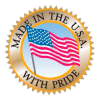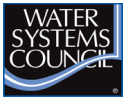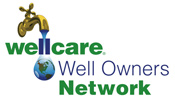History of Lead Use
Over the last decade, the rise and prevalence of lead contamination events in the United States has risen dramatically. One of the main reasons is that public water systems rely on lead service lines installed nearly a century ago to deliver clean and treated water. Community and public water systems are under increased pressure to replace these failing and dangerous systems. In 2015, the Flint Water Crisis became a national news story and the poster child for an ever growing movement to remove and replace lead service lines across the country. After learning that the city water was contaminated and poisoning its citizens, it was determined that changing the source of the city's water to a local river, and a failure by the city to take the correct preventative measures to treat the water lead to the corrosion of hundreds of miles of lead service lines across the city. The water was often dirty, and found to have excessively high levels of lead in many homes, some with levels as high as 13,000 ppb or around 867 times higher than the EPA MCL. This highlighted the need to replace lead service lines across the United States and address this ever growing problem. Lead, like Arsenic and Mercury, is listed under the EPA's Primary drinking water standards, and is dangerous even in very low concentrations. The primary drinking water standard (MCL) for Lead is 15 parts per billion (ppb) or 15 micro grams per liter (µg/L), but the MCLG is 0. Lead has been used for thousands of years because of its soft and malleable nature. Its been used to make jewelry, paints, lead-acid batteries piping, and as an additive in gasoline.
Health Concerns
Lead service lines and lead solder had been widely used in public and residential water systems up until the dangers of lead were made apparent during the late 20th century. In 1991, the EPA issued the Lead Copper Ruling in accordance with the Safe Drinking Water Act to limit the levels of lead and copper in drinking water systems. While lead is naturally occurring in groundwater formations and occurs because of the dissolution of the rock bearing it, the most common cause of contamination in drinking water is from lead service lines, lead solder, and plumbing fixtures. The health concerns from lead exposure are well documented and can lead to a number of health problems. Lead exposure in children can cause severe cognitive and neurological disorders, disrupt brain development, and damage to all of the body's major systems. Lead is most commonly found in complexes of Pb(OH)2, PbCO3 and Pb2O, but can take on any number of forms from dissolved to precipitated forms. The image below is provided by the National Science Foundation through Virginia Tech Researchers that investigated lead poisoning incidents in children linked to drinking water. They found that lead particulate from solder and other sources can get trapped in faucet aerators and eventually be dislodged posing a serious health risk to anyone consuming them.
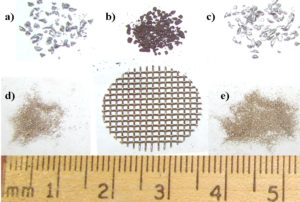
Virginia Tech researchers examined different types of leaded particles that can attach to screens or sampling containers and may not register during testing: a) pure lead, b) lead (IV), c) solder (50:50 lead:tin), d) red brass and e) yellow brass. "Courtesy: National Science Foundation".
Treatment Options
Similar to arsenic, the goal is to always have a complete reduction of lead to non detectable levels and multiple steps are taken to meet that goal. The most common method would be the use of a strong acid cation exchange water softener regenerated with sodium chloride to remove any dissolved lead. Some lead adsorbent specific medias and special carbon block filters are available as well, which are useful for removing particulate and dissolved lead. However, it is important to consider that lead solder used in piping after a water softener is still a potentially dangerous source for lead contamination and exposure. Polyethylene composite plastic piping is a safe and effective alternative to copper pipes that require soldering for joints. It is always advisable to use a POU lead reduction device for drinking and cooking water. There are numerous POU options for lead reduction, including reverse osmosis systems and numerous NSF/ANSI 53 certified POU filtration systems. When considering different NSF/ANSI 53 certified filtration systems, it is important to identify what specific contaminants the given filter is certified to reduce. Per NSF/ANSI 53 certification requirements, said information should be clearly stated, and be readily available for consumers to access. Said information is frequently displayed on product packaging.




